Toyota's Leadership and Management: Roles, Theories, and Operations
VerifiedAdded on 2020/12/09
|19
|6732
|190
Report
AI Summary
This report provides a comprehensive analysis of leadership and management practices within Toyota, a leading automotive company. It begins by outlining Toyota's organizational structure and then delves into a comparison of the roles and characteristics of leaders and managers, highlighting the differences in their responsibilities and approaches. The report further explores various leadership and management theories, including scientific, behavioral, and systems theories, and their application within Toyota. It also examines the key operational functions and their significance in the company's success. Finally, the report assesses the impact of external business environment factors on operational management and decision-making processes of leaders and managers within Toyota, offering a holistic view of the company's management strategies.
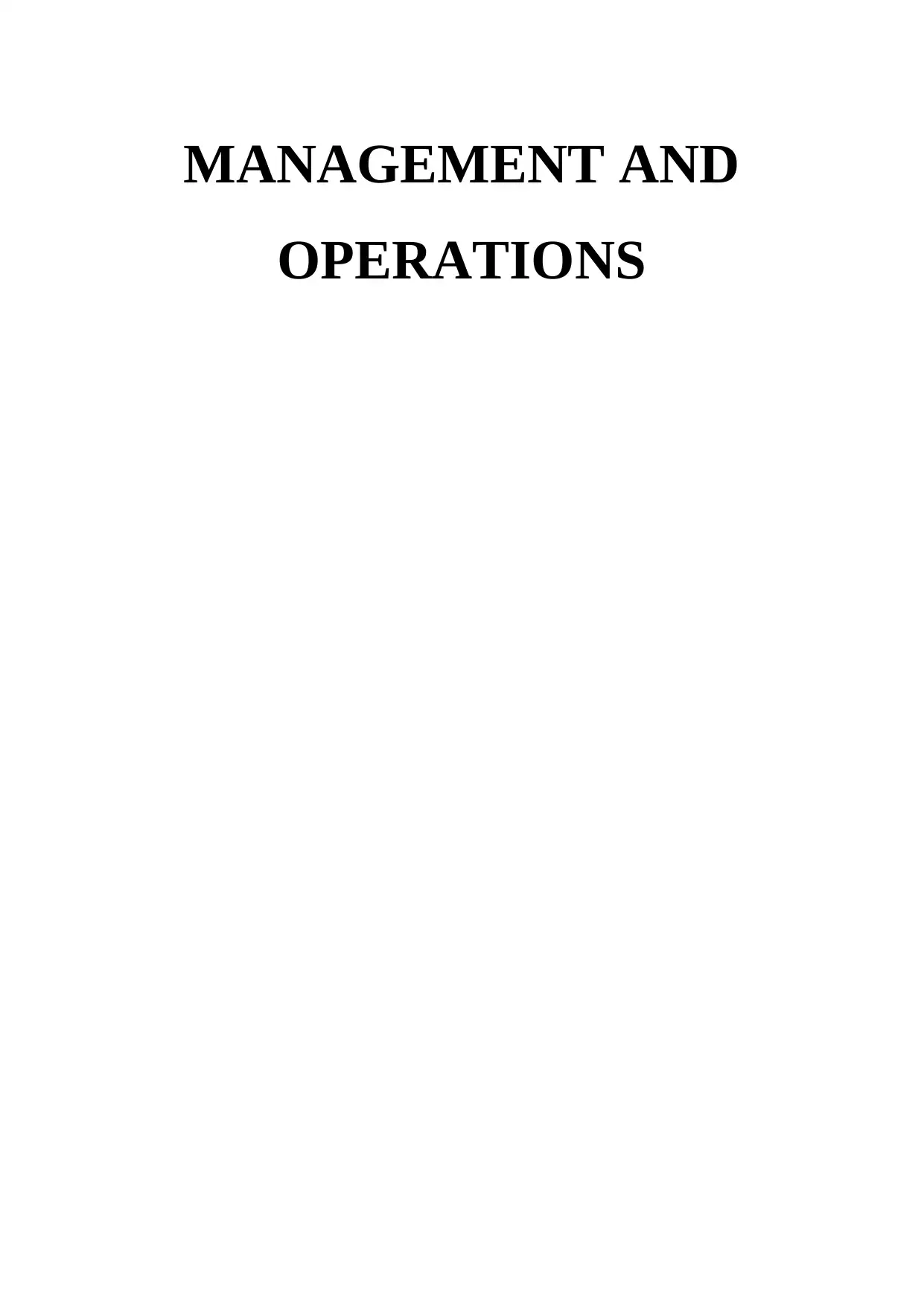
MANAGEMENT AND
OPERATIONS
OPERATIONS
Paraphrase This Document
Need a fresh take? Get an instant paraphrase of this document with our AI Paraphraser
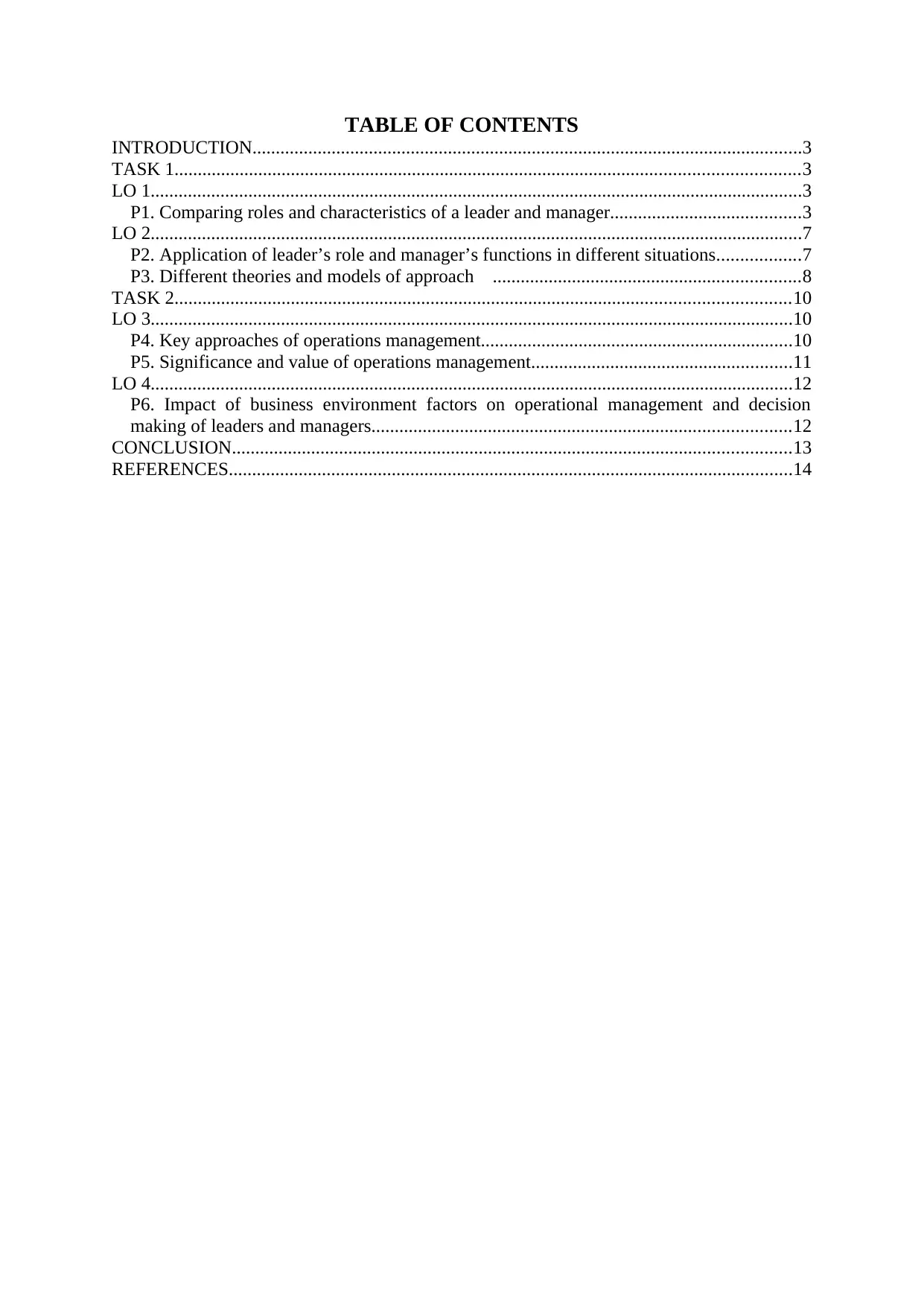
TABLE OF CONTENTS
INTRODUCTION......................................................................................................................3
TASK 1......................................................................................................................................3
LO 1............................................................................................................................................3
P1. Comparing roles and characteristics of a leader and manager.........................................3
LO 2............................................................................................................................................7
P2. Application of leader’s role and manager’s functions in different situations..................7
P3. Different theories and models of approach ..................................................................8
TASK 2....................................................................................................................................10
LO 3..........................................................................................................................................10
P4. Key approaches of operations management...................................................................10
P5. Significance and value of operations management........................................................11
LO 4..........................................................................................................................................12
P6. Impact of business environment factors on operational management and decision
making of leaders and managers..........................................................................................12
CONCLUSION........................................................................................................................13
REFERENCES.........................................................................................................................14
INTRODUCTION......................................................................................................................3
TASK 1......................................................................................................................................3
LO 1............................................................................................................................................3
P1. Comparing roles and characteristics of a leader and manager.........................................3
LO 2............................................................................................................................................7
P2. Application of leader’s role and manager’s functions in different situations..................7
P3. Different theories and models of approach ..................................................................8
TASK 2....................................................................................................................................10
LO 3..........................................................................................................................................10
P4. Key approaches of operations management...................................................................10
P5. Significance and value of operations management........................................................11
LO 4..........................................................................................................................................12
P6. Impact of business environment factors on operational management and decision
making of leaders and managers..........................................................................................12
CONCLUSION........................................................................................................................13
REFERENCES.........................................................................................................................14
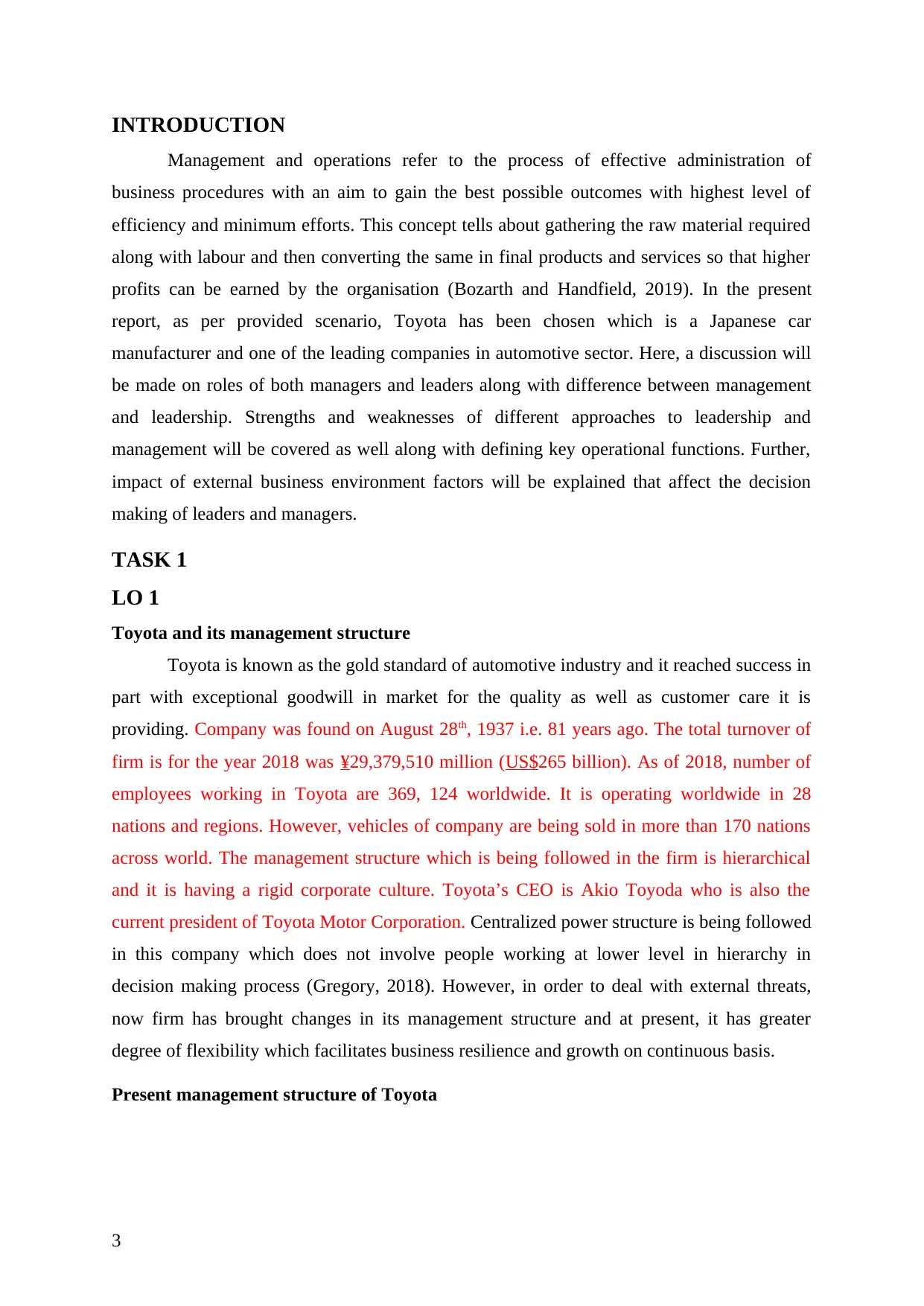
INTRODUCTION
Management and operations refer to the process of effective administration of
business procedures with an aim to gain the best possible outcomes with highest level of
efficiency and minimum efforts. This concept tells about gathering the raw material required
along with labour and then converting the same in final products and services so that higher
profits can be earned by the organisation (Bozarth and Handfield, 2019). In the present
report, as per provided scenario, Toyota has been chosen which is a Japanese car
manufacturer and one of the leading companies in automotive sector. Here, a discussion will
be made on roles of both managers and leaders along with difference between management
and leadership. Strengths and weaknesses of different approaches to leadership and
management will be covered as well along with defining key operational functions. Further,
impact of external business environment factors will be explained that affect the decision
making of leaders and managers.
TASK 1
LO 1
Toyota and its management structure
Toyota is known as the gold standard of automotive industry and it reached success in
part with exceptional goodwill in market for the quality as well as customer care it is
providing. Company was found on August 28th, 1937 i.e. 81 years ago. The total turnover of
firm is for the year 2018 was ¥29,379,510 million (US$265 billion). As of 2018, number of
employees working in Toyota are 369, 124 worldwide. It is operating worldwide in 28
nations and regions. However, vehicles of company are being sold in more than 170 nations
across world. The management structure which is being followed in the firm is hierarchical
and it is having a rigid corporate culture. Toyota’s CEO is Akio Toyoda who is also the
current president of Toyota Motor Corporation. Centralized power structure is being followed
in this company which does not involve people working at lower level in hierarchy in
decision making process (Gregory, 2018). However, in order to deal with external threats,
now firm has brought changes in its management structure and at present, it has greater
degree of flexibility which facilitates business resilience and growth on continuous basis.
Present management structure of Toyota
3
Management and operations refer to the process of effective administration of
business procedures with an aim to gain the best possible outcomes with highest level of
efficiency and minimum efforts. This concept tells about gathering the raw material required
along with labour and then converting the same in final products and services so that higher
profits can be earned by the organisation (Bozarth and Handfield, 2019). In the present
report, as per provided scenario, Toyota has been chosen which is a Japanese car
manufacturer and one of the leading companies in automotive sector. Here, a discussion will
be made on roles of both managers and leaders along with difference between management
and leadership. Strengths and weaknesses of different approaches to leadership and
management will be covered as well along with defining key operational functions. Further,
impact of external business environment factors will be explained that affect the decision
making of leaders and managers.
TASK 1
LO 1
Toyota and its management structure
Toyota is known as the gold standard of automotive industry and it reached success in
part with exceptional goodwill in market for the quality as well as customer care it is
providing. Company was found on August 28th, 1937 i.e. 81 years ago. The total turnover of
firm is for the year 2018 was ¥29,379,510 million (US$265 billion). As of 2018, number of
employees working in Toyota are 369, 124 worldwide. It is operating worldwide in 28
nations and regions. However, vehicles of company are being sold in more than 170 nations
across world. The management structure which is being followed in the firm is hierarchical
and it is having a rigid corporate culture. Toyota’s CEO is Akio Toyoda who is also the
current president of Toyota Motor Corporation. Centralized power structure is being followed
in this company which does not involve people working at lower level in hierarchy in
decision making process (Gregory, 2018). However, in order to deal with external threats,
now firm has brought changes in its management structure and at present, it has greater
degree of flexibility which facilitates business resilience and growth on continuous basis.
Present management structure of Toyota
3
⊘ This is a preview!⊘
Do you want full access?
Subscribe today to unlock all pages.

Trusted by 1+ million students worldwide
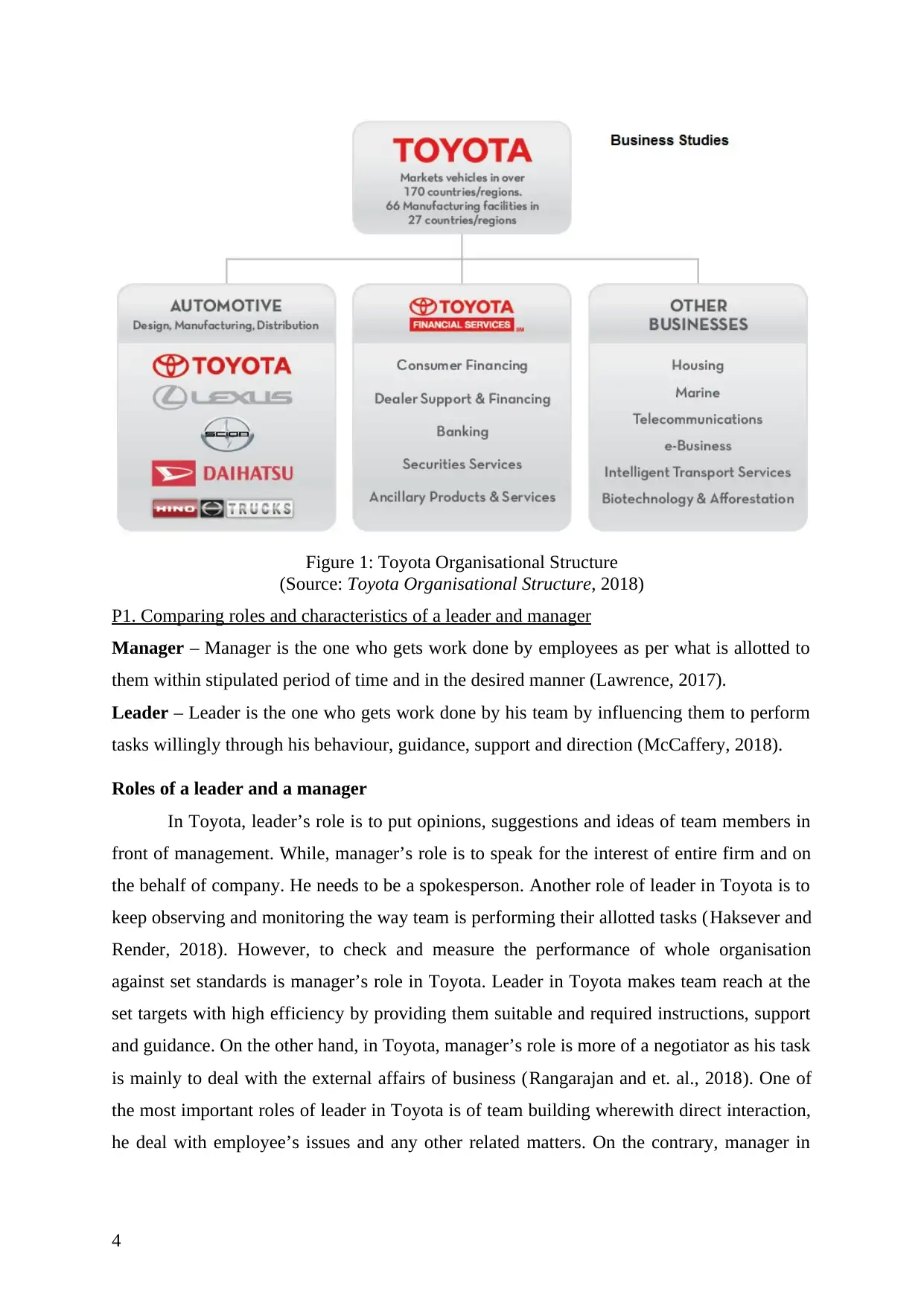
Figure 1: Toyota Organisational Structure
(Source: Toyota Organisational Structure, 2018)
P1. Comparing roles and characteristics of a leader and manager
Manager – Manager is the one who gets work done by employees as per what is allotted to
them within stipulated period of time and in the desired manner (Lawrence, 2017).
Leader – Leader is the one who gets work done by his team by influencing them to perform
tasks willingly through his behaviour, guidance, support and direction (McCaffery, 2018).
Roles of a leader and a manager
In Toyota, leader’s role is to put opinions, suggestions and ideas of team members in
front of management. While, manager’s role is to speak for the interest of entire firm and on
the behalf of company. He needs to be a spokesperson. Another role of leader in Toyota is to
keep observing and monitoring the way team is performing their allotted tasks (Haksever and
Render, 2018). However, to check and measure the performance of whole organisation
against set standards is manager’s role in Toyota. Leader in Toyota makes team reach at the
set targets with high efficiency by providing them suitable and required instructions, support
and guidance. On the other hand, in Toyota, manager’s role is more of a negotiator as his task
is mainly to deal with the external affairs of business (Rangarajan and et. al., 2018). One of
the most important roles of leader in Toyota is of team building wherewith direct interaction,
he deal with employee’s issues and any other related matters. On the contrary, manager in
4
(Source: Toyota Organisational Structure, 2018)
P1. Comparing roles and characteristics of a leader and manager
Manager – Manager is the one who gets work done by employees as per what is allotted to
them within stipulated period of time and in the desired manner (Lawrence, 2017).
Leader – Leader is the one who gets work done by his team by influencing them to perform
tasks willingly through his behaviour, guidance, support and direction (McCaffery, 2018).
Roles of a leader and a manager
In Toyota, leader’s role is to put opinions, suggestions and ideas of team members in
front of management. While, manager’s role is to speak for the interest of entire firm and on
the behalf of company. He needs to be a spokesperson. Another role of leader in Toyota is to
keep observing and monitoring the way team is performing their allotted tasks (Haksever and
Render, 2018). However, to check and measure the performance of whole organisation
against set standards is manager’s role in Toyota. Leader in Toyota makes team reach at the
set targets with high efficiency by providing them suitable and required instructions, support
and guidance. On the other hand, in Toyota, manager’s role is more of a negotiator as his task
is mainly to deal with the external affairs of business (Rangarajan and et. al., 2018). One of
the most important roles of leader in Toyota is of team building wherewith direct interaction,
he deal with employee’s issues and any other related matters. On the contrary, manager in
4
Paraphrase This Document
Need a fresh take? Get an instant paraphrase of this document with our AI Paraphraser
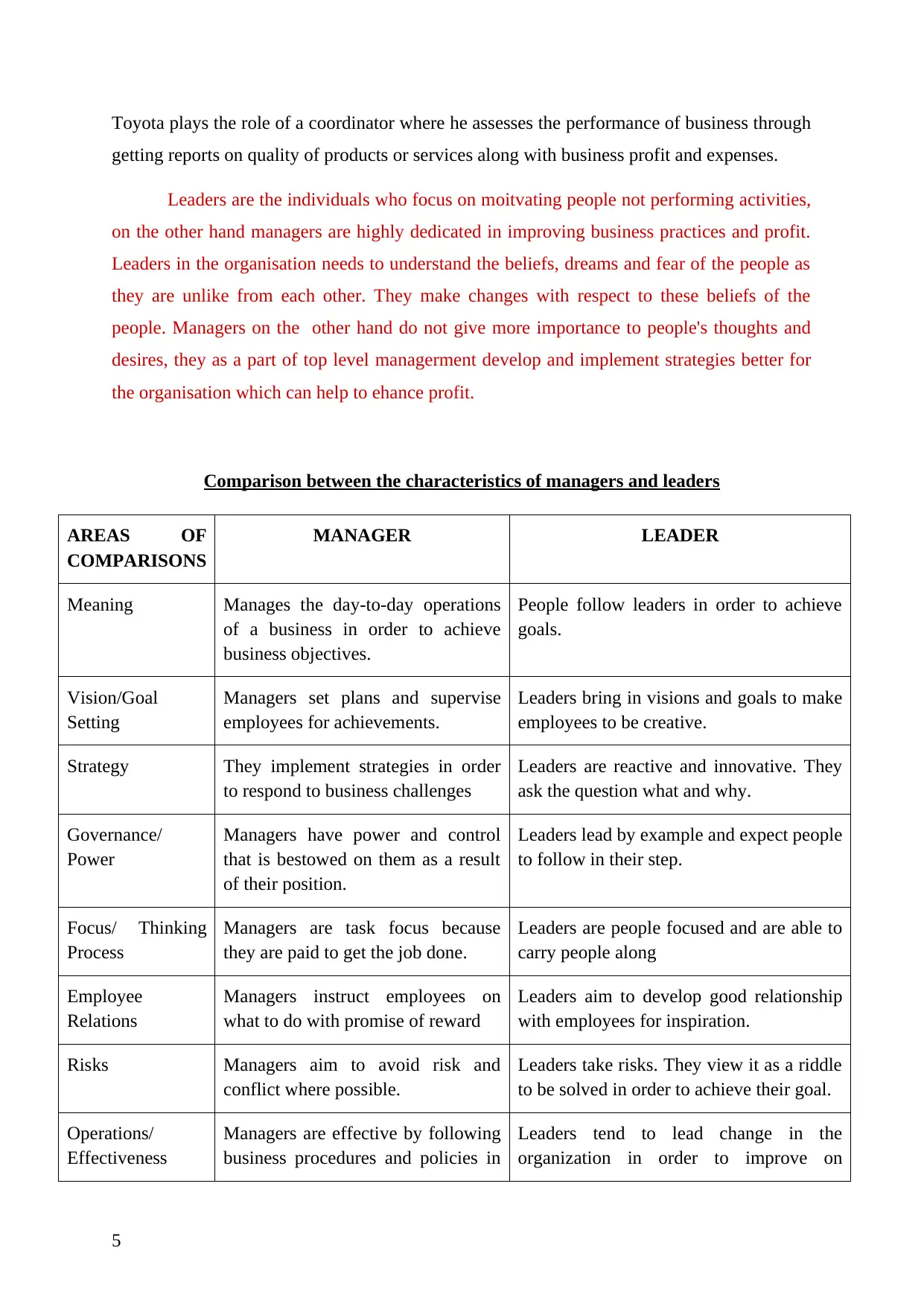
Toyota plays the role of a coordinator where he assesses the performance of business through
getting reports on quality of products or services along with business profit and expenses.
Leaders are the individuals who focus on moitvating people not performing activities,
on the other hand managers are highly dedicated in improving business practices and profit.
Leaders in the organisation needs to understand the beliefs, dreams and fear of the people as
they are unlike from each other. They make changes with respect to these beliefs of the
people. Managers on the other hand do not give more importance to people's thoughts and
desires, they as a part of top level managerment develop and implement strategies better for
the organisation which can help to ehance profit.
Comparison between the characteristics of managers and leaders
AREAS OF
COMPARISONS
MANAGER LEADER
Meaning Manages the day-to-day operations
of a business in order to achieve
business objectives.
People follow leaders in order to achieve
goals.
Vision/Goal
Setting
Managers set plans and supervise
employees for achievements.
Leaders bring in visions and goals to make
employees to be creative.
Strategy They implement strategies in order
to respond to business challenges
Leaders are reactive and innovative. They
ask the question what and why.
Governance/
Power
Managers have power and control
that is bestowed on them as a result
of their position.
Leaders lead by example and expect people
to follow in their step.
Focus/ Thinking
Process
Managers are task focus because
they are paid to get the job done.
Leaders are people focused and are able to
carry people along
Employee
Relations
Managers instruct employees on
what to do with promise of reward
Leaders aim to develop good relationship
with employees for inspiration.
Risks Managers aim to avoid risk and
conflict where possible.
Leaders take risks. They view it as a riddle
to be solved in order to achieve their goal.
Operations/
Effectiveness
Managers are effective by following
business procedures and policies in
Leaders tend to lead change in the
organization in order to improve on
5
getting reports on quality of products or services along with business profit and expenses.
Leaders are the individuals who focus on moitvating people not performing activities,
on the other hand managers are highly dedicated in improving business practices and profit.
Leaders in the organisation needs to understand the beliefs, dreams and fear of the people as
they are unlike from each other. They make changes with respect to these beliefs of the
people. Managers on the other hand do not give more importance to people's thoughts and
desires, they as a part of top level managerment develop and implement strategies better for
the organisation which can help to ehance profit.
Comparison between the characteristics of managers and leaders
AREAS OF
COMPARISONS
MANAGER LEADER
Meaning Manages the day-to-day operations
of a business in order to achieve
business objectives.
People follow leaders in order to achieve
goals.
Vision/Goal
Setting
Managers set plans and supervise
employees for achievements.
Leaders bring in visions and goals to make
employees to be creative.
Strategy They implement strategies in order
to respond to business challenges
Leaders are reactive and innovative. They
ask the question what and why.
Governance/
Power
Managers have power and control
that is bestowed on them as a result
of their position.
Leaders lead by example and expect people
to follow in their step.
Focus/ Thinking
Process
Managers are task focus because
they are paid to get the job done.
Leaders are people focused and are able to
carry people along
Employee
Relations
Managers instruct employees on
what to do with promise of reward
Leaders aim to develop good relationship
with employees for inspiration.
Risks Managers aim to avoid risk and
conflict where possible.
Leaders take risks. They view it as a riddle
to be solved in order to achieve their goal.
Operations/
Effectiveness
Managers are effective by following
business procedures and policies in
Leaders tend to lead change in the
organization in order to improve on
5
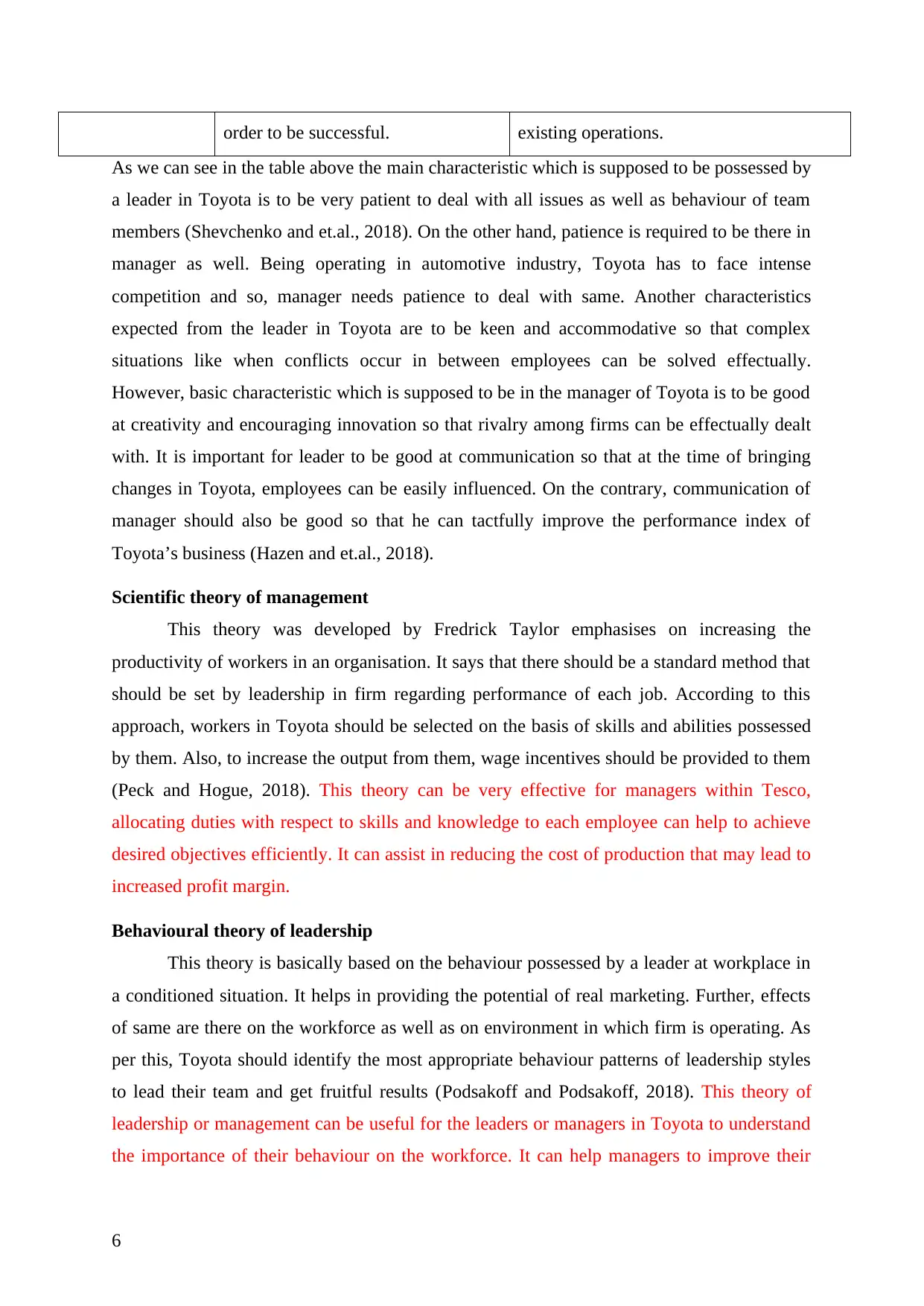
order to be successful. existing operations.
As we can see in the table above the main characteristic which is supposed to be possessed by
a leader in Toyota is to be very patient to deal with all issues as well as behaviour of team
members (Shevchenko and et.al., 2018). On the other hand, patience is required to be there in
manager as well. Being operating in automotive industry, Toyota has to face intense
competition and so, manager needs patience to deal with same. Another characteristics
expected from the leader in Toyota are to be keen and accommodative so that complex
situations like when conflicts occur in between employees can be solved effectually.
However, basic characteristic which is supposed to be in the manager of Toyota is to be good
at creativity and encouraging innovation so that rivalry among firms can be effectually dealt
with. It is important for leader to be good at communication so that at the time of bringing
changes in Toyota, employees can be easily influenced. On the contrary, communication of
manager should also be good so that he can tactfully improve the performance index of
Toyota’s business (Hazen and et.al., 2018).
Scientific theory of management
This theory was developed by Fredrick Taylor emphasises on increasing the
productivity of workers in an organisation. It says that there should be a standard method that
should be set by leadership in firm regarding performance of each job. According to this
approach, workers in Toyota should be selected on the basis of skills and abilities possessed
by them. Also, to increase the output from them, wage incentives should be provided to them
(Peck and Hogue, 2018). This theory can be very effective for managers within Tesco,
allocating duties with respect to skills and knowledge to each employee can help to achieve
desired objectives efficiently. It can assist in reducing the cost of production that may lead to
increased profit margin.
Behavioural theory of leadership
This theory is basically based on the behaviour possessed by a leader at workplace in
a conditioned situation. It helps in providing the potential of real marketing. Further, effects
of same are there on the workforce as well as on environment in which firm is operating. As
per this, Toyota should identify the most appropriate behaviour patterns of leadership styles
to lead their team and get fruitful results (Podsakoff and Podsakoff, 2018). This theory of
leadership or management can be useful for the leaders or managers in Toyota to understand
the importance of their behaviour on the workforce. It can help managers to improve their
6
As we can see in the table above the main characteristic which is supposed to be possessed by
a leader in Toyota is to be very patient to deal with all issues as well as behaviour of team
members (Shevchenko and et.al., 2018). On the other hand, patience is required to be there in
manager as well. Being operating in automotive industry, Toyota has to face intense
competition and so, manager needs patience to deal with same. Another characteristics
expected from the leader in Toyota are to be keen and accommodative so that complex
situations like when conflicts occur in between employees can be solved effectually.
However, basic characteristic which is supposed to be in the manager of Toyota is to be good
at creativity and encouraging innovation so that rivalry among firms can be effectually dealt
with. It is important for leader to be good at communication so that at the time of bringing
changes in Toyota, employees can be easily influenced. On the contrary, communication of
manager should also be good so that he can tactfully improve the performance index of
Toyota’s business (Hazen and et.al., 2018).
Scientific theory of management
This theory was developed by Fredrick Taylor emphasises on increasing the
productivity of workers in an organisation. It says that there should be a standard method that
should be set by leadership in firm regarding performance of each job. According to this
approach, workers in Toyota should be selected on the basis of skills and abilities possessed
by them. Also, to increase the output from them, wage incentives should be provided to them
(Peck and Hogue, 2018). This theory can be very effective for managers within Tesco,
allocating duties with respect to skills and knowledge to each employee can help to achieve
desired objectives efficiently. It can assist in reducing the cost of production that may lead to
increased profit margin.
Behavioural theory of leadership
This theory is basically based on the behaviour possessed by a leader at workplace in
a conditioned situation. It helps in providing the potential of real marketing. Further, effects
of same are there on the workforce as well as on environment in which firm is operating. As
per this, Toyota should identify the most appropriate behaviour patterns of leadership styles
to lead their team and get fruitful results (Podsakoff and Podsakoff, 2018). This theory of
leadership or management can be useful for the leaders or managers in Toyota to understand
the importance of their behaviour on the workforce. It can help managers to improve their
6
⊘ This is a preview!⊘
Do you want full access?
Subscribe today to unlock all pages.

Trusted by 1+ million students worldwide
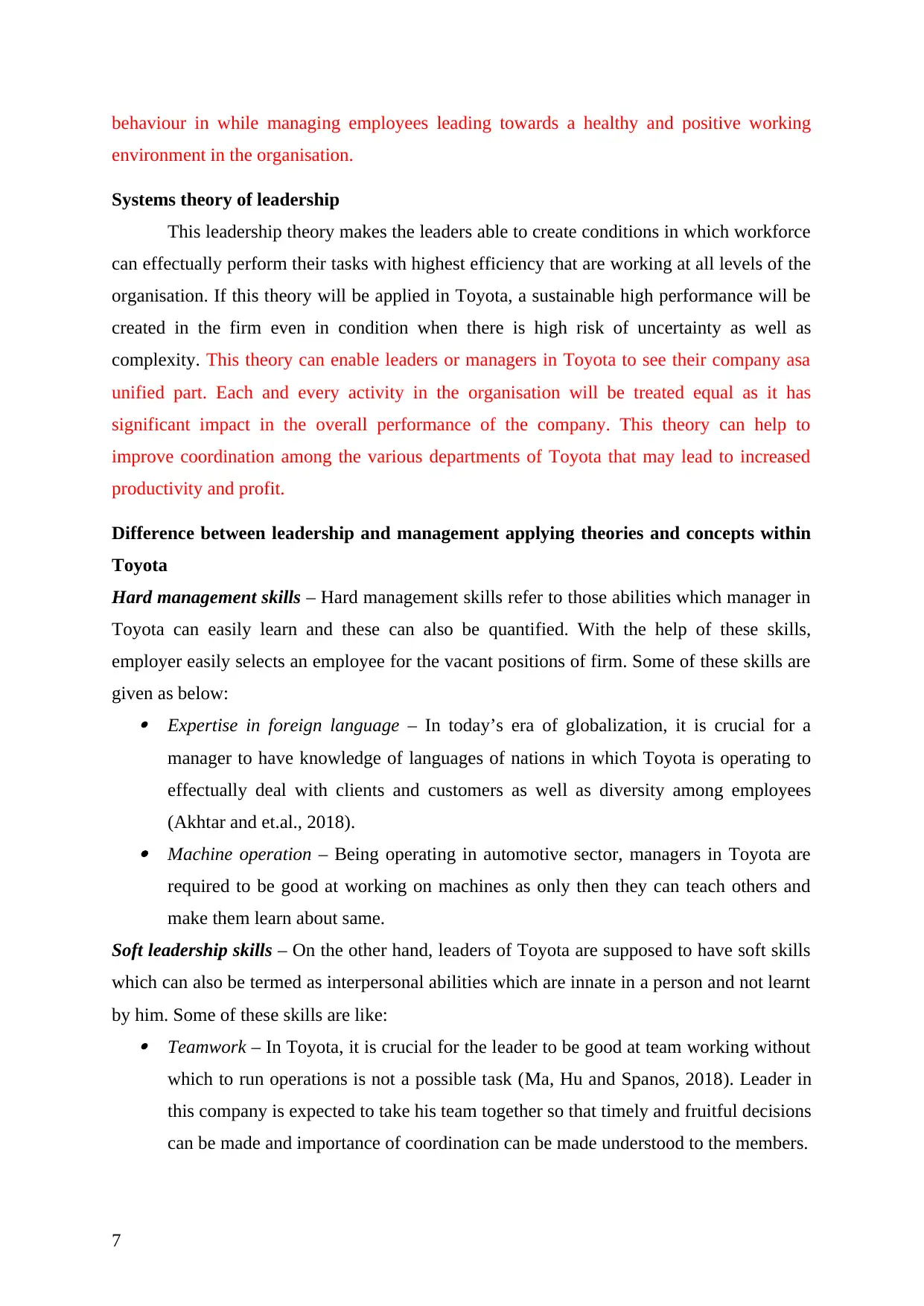
behaviour in while managing employees leading towards a healthy and positive working
environment in the organisation.
Systems theory of leadership
This leadership theory makes the leaders able to create conditions in which workforce
can effectually perform their tasks with highest efficiency that are working at all levels of the
organisation. If this theory will be applied in Toyota, a sustainable high performance will be
created in the firm even in condition when there is high risk of uncertainty as well as
complexity. This theory can enable leaders or managers in Toyota to see their company asa
unified part. Each and every activity in the organisation will be treated equal as it has
significant impact in the overall performance of the company. This theory can help to
improve coordination among the various departments of Toyota that may lead to increased
productivity and profit.
Difference between leadership and management applying theories and concepts within
Toyota
Hard management skills – Hard management skills refer to those abilities which manager in
Toyota can easily learn and these can also be quantified. With the help of these skills,
employer easily selects an employee for the vacant positions of firm. Some of these skills are
given as below: Expertise in foreign language – In today’s era of globalization, it is crucial for a
manager to have knowledge of languages of nations in which Toyota is operating to
effectually deal with clients and customers as well as diversity among employees
(Akhtar and et.al., 2018). Machine operation – Being operating in automotive sector, managers in Toyota are
required to be good at working on machines as only then they can teach others and
make them learn about same.
Soft leadership skills – On the other hand, leaders of Toyota are supposed to have soft skills
which can also be termed as interpersonal abilities which are innate in a person and not learnt
by him. Some of these skills are like: Teamwork – In Toyota, it is crucial for the leader to be good at team working without
which to run operations is not a possible task (Ma, Hu and Spanos, 2018). Leader in
this company is expected to take his team together so that timely and fruitful decisions
can be made and importance of coordination can be made understood to the members.
7
environment in the organisation.
Systems theory of leadership
This leadership theory makes the leaders able to create conditions in which workforce
can effectually perform their tasks with highest efficiency that are working at all levels of the
organisation. If this theory will be applied in Toyota, a sustainable high performance will be
created in the firm even in condition when there is high risk of uncertainty as well as
complexity. This theory can enable leaders or managers in Toyota to see their company asa
unified part. Each and every activity in the organisation will be treated equal as it has
significant impact in the overall performance of the company. This theory can help to
improve coordination among the various departments of Toyota that may lead to increased
productivity and profit.
Difference between leadership and management applying theories and concepts within
Toyota
Hard management skills – Hard management skills refer to those abilities which manager in
Toyota can easily learn and these can also be quantified. With the help of these skills,
employer easily selects an employee for the vacant positions of firm. Some of these skills are
given as below: Expertise in foreign language – In today’s era of globalization, it is crucial for a
manager to have knowledge of languages of nations in which Toyota is operating to
effectually deal with clients and customers as well as diversity among employees
(Akhtar and et.al., 2018). Machine operation – Being operating in automotive sector, managers in Toyota are
required to be good at working on machines as only then they can teach others and
make them learn about same.
Soft leadership skills – On the other hand, leaders of Toyota are supposed to have soft skills
which can also be termed as interpersonal abilities which are innate in a person and not learnt
by him. Some of these skills are like: Teamwork – In Toyota, it is crucial for the leader to be good at team working without
which to run operations is not a possible task (Ma, Hu and Spanos, 2018). Leader in
this company is expected to take his team together so that timely and fruitful decisions
can be made and importance of coordination can be made understood to the members.
7
Paraphrase This Document
Need a fresh take? Get an instant paraphrase of this document with our AI Paraphraser
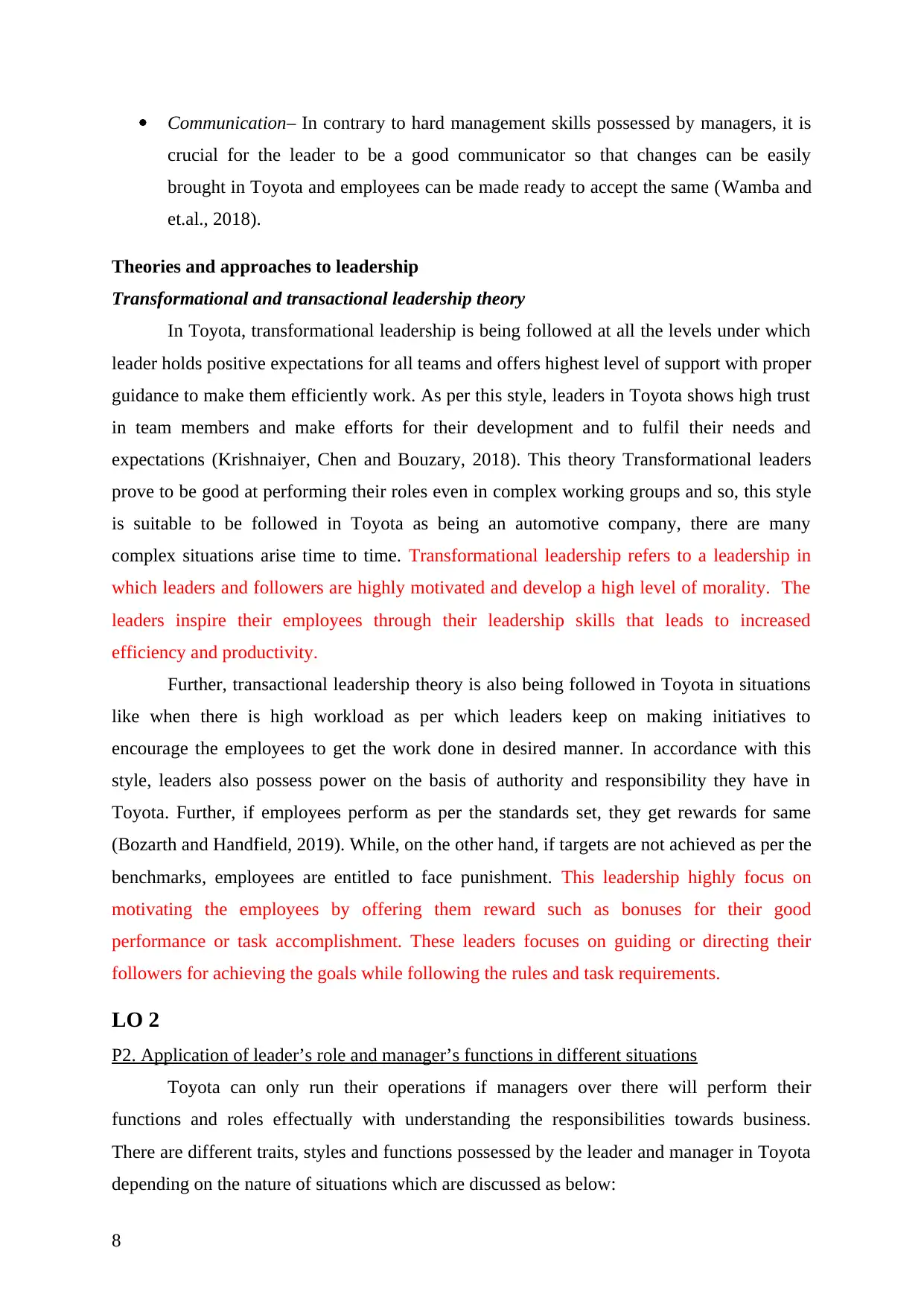
Communication– In contrary to hard management skills possessed by managers, it is
crucial for the leader to be a good communicator so that changes can be easily
brought in Toyota and employees can be made ready to accept the same (Wamba and
et.al., 2018).
Theories and approaches to leadership
Transformational and transactional leadership theory
In Toyota, transformational leadership is being followed at all the levels under which
leader holds positive expectations for all teams and offers highest level of support with proper
guidance to make them efficiently work. As per this style, leaders in Toyota shows high trust
in team members and make efforts for their development and to fulfil their needs and
expectations (Krishnaiyer, Chen and Bouzary, 2018). This theory Transformational leaders
prove to be good at performing their roles even in complex working groups and so, this style
is suitable to be followed in Toyota as being an automotive company, there are many
complex situations arise time to time. Transformational leadership refers to a leadership in
which leaders and followers are highly motivated and develop a high level of morality. The
leaders inspire their employees through their leadership skills that leads to increased
efficiency and productivity.
Further, transactional leadership theory is also being followed in Toyota in situations
like when there is high workload as per which leaders keep on making initiatives to
encourage the employees to get the work done in desired manner. In accordance with this
style, leaders also possess power on the basis of authority and responsibility they have in
Toyota. Further, if employees perform as per the standards set, they get rewards for same
(Bozarth and Handfield, 2019). While, on the other hand, if targets are not achieved as per the
benchmarks, employees are entitled to face punishment. This leadership highly focus on
motivating the employees by offering them reward such as bonuses for their good
performance or task accomplishment. These leaders focuses on guiding or directing their
followers for achieving the goals while following the rules and task requirements.
LO 2
P2. Application of leader’s role and manager’s functions in different situations
Toyota can only run their operations if managers over there will perform their
functions and roles effectually with understanding the responsibilities towards business.
There are different traits, styles and functions possessed by the leader and manager in Toyota
depending on the nature of situations which are discussed as below:
8
crucial for the leader to be a good communicator so that changes can be easily
brought in Toyota and employees can be made ready to accept the same (Wamba and
et.al., 2018).
Theories and approaches to leadership
Transformational and transactional leadership theory
In Toyota, transformational leadership is being followed at all the levels under which
leader holds positive expectations for all teams and offers highest level of support with proper
guidance to make them efficiently work. As per this style, leaders in Toyota shows high trust
in team members and make efforts for their development and to fulfil their needs and
expectations (Krishnaiyer, Chen and Bouzary, 2018). This theory Transformational leaders
prove to be good at performing their roles even in complex working groups and so, this style
is suitable to be followed in Toyota as being an automotive company, there are many
complex situations arise time to time. Transformational leadership refers to a leadership in
which leaders and followers are highly motivated and develop a high level of morality. The
leaders inspire their employees through their leadership skills that leads to increased
efficiency and productivity.
Further, transactional leadership theory is also being followed in Toyota in situations
like when there is high workload as per which leaders keep on making initiatives to
encourage the employees to get the work done in desired manner. In accordance with this
style, leaders also possess power on the basis of authority and responsibility they have in
Toyota. Further, if employees perform as per the standards set, they get rewards for same
(Bozarth and Handfield, 2019). While, on the other hand, if targets are not achieved as per the
benchmarks, employees are entitled to face punishment. This leadership highly focus on
motivating the employees by offering them reward such as bonuses for their good
performance or task accomplishment. These leaders focuses on guiding or directing their
followers for achieving the goals while following the rules and task requirements.
LO 2
P2. Application of leader’s role and manager’s functions in different situations
Toyota can only run their operations if managers over there will perform their
functions and roles effectually with understanding the responsibilities towards business.
There are different traits, styles and functions possessed by the leader and manager in Toyota
depending on the nature of situations which are discussed as below:
8
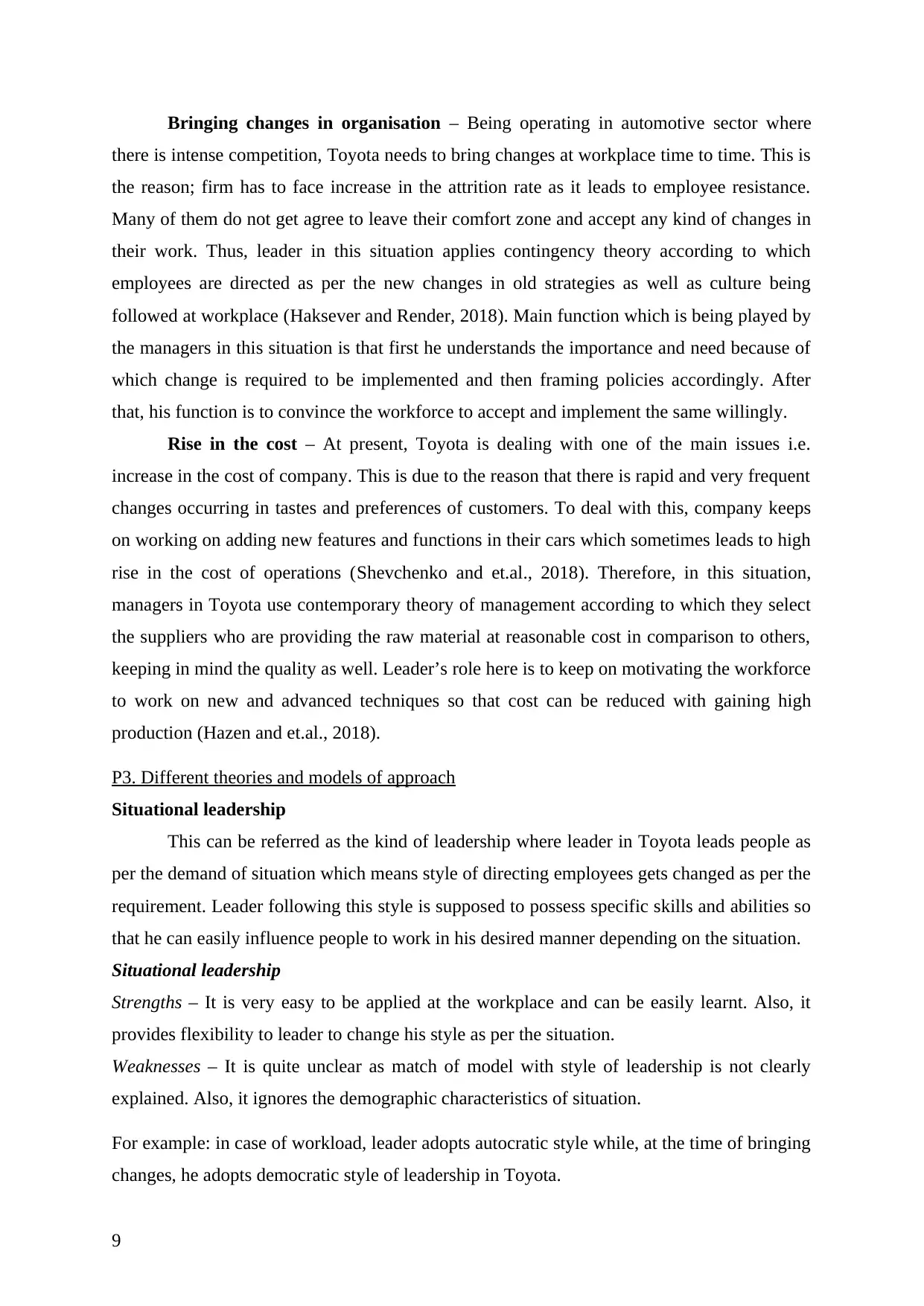
Bringing changes in organisation – Being operating in automotive sector where
there is intense competition, Toyota needs to bring changes at workplace time to time. This is
the reason; firm has to face increase in the attrition rate as it leads to employee resistance.
Many of them do not get agree to leave their comfort zone and accept any kind of changes in
their work. Thus, leader in this situation applies contingency theory according to which
employees are directed as per the new changes in old strategies as well as culture being
followed at workplace (Haksever and Render, 2018). Main function which is being played by
the managers in this situation is that first he understands the importance and need because of
which change is required to be implemented and then framing policies accordingly. After
that, his function is to convince the workforce to accept and implement the same willingly.
Rise in the cost – At present, Toyota is dealing with one of the main issues i.e.
increase in the cost of company. This is due to the reason that there is rapid and very frequent
changes occurring in tastes and preferences of customers. To deal with this, company keeps
on working on adding new features and functions in their cars which sometimes leads to high
rise in the cost of operations (Shevchenko and et.al., 2018). Therefore, in this situation,
managers in Toyota use contemporary theory of management according to which they select
the suppliers who are providing the raw material at reasonable cost in comparison to others,
keeping in mind the quality as well. Leader’s role here is to keep on motivating the workforce
to work on new and advanced techniques so that cost can be reduced with gaining high
production (Hazen and et.al., 2018).
P3. Different theories and models of approach
Situational leadership
This can be referred as the kind of leadership where leader in Toyota leads people as
per the demand of situation which means style of directing employees gets changed as per the
requirement. Leader following this style is supposed to possess specific skills and abilities so
that he can easily influence people to work in his desired manner depending on the situation.
Situational leadership
Strengths – It is very easy to be applied at the workplace and can be easily learnt. Also, it
provides flexibility to leader to change his style as per the situation.
Weaknesses – It is quite unclear as match of model with style of leadership is not clearly
explained. Also, it ignores the demographic characteristics of situation.
For example: in case of workload, leader adopts autocratic style while, at the time of bringing
changes, he adopts democratic style of leadership in Toyota.
9
there is intense competition, Toyota needs to bring changes at workplace time to time. This is
the reason; firm has to face increase in the attrition rate as it leads to employee resistance.
Many of them do not get agree to leave their comfort zone and accept any kind of changes in
their work. Thus, leader in this situation applies contingency theory according to which
employees are directed as per the new changes in old strategies as well as culture being
followed at workplace (Haksever and Render, 2018). Main function which is being played by
the managers in this situation is that first he understands the importance and need because of
which change is required to be implemented and then framing policies accordingly. After
that, his function is to convince the workforce to accept and implement the same willingly.
Rise in the cost – At present, Toyota is dealing with one of the main issues i.e.
increase in the cost of company. This is due to the reason that there is rapid and very frequent
changes occurring in tastes and preferences of customers. To deal with this, company keeps
on working on adding new features and functions in their cars which sometimes leads to high
rise in the cost of operations (Shevchenko and et.al., 2018). Therefore, in this situation,
managers in Toyota use contemporary theory of management according to which they select
the suppliers who are providing the raw material at reasonable cost in comparison to others,
keeping in mind the quality as well. Leader’s role here is to keep on motivating the workforce
to work on new and advanced techniques so that cost can be reduced with gaining high
production (Hazen and et.al., 2018).
P3. Different theories and models of approach
Situational leadership
This can be referred as the kind of leadership where leader in Toyota leads people as
per the demand of situation which means style of directing employees gets changed as per the
requirement. Leader following this style is supposed to possess specific skills and abilities so
that he can easily influence people to work in his desired manner depending on the situation.
Situational leadership
Strengths – It is very easy to be applied at the workplace and can be easily learnt. Also, it
provides flexibility to leader to change his style as per the situation.
Weaknesses – It is quite unclear as match of model with style of leadership is not clearly
explained. Also, it ignores the demographic characteristics of situation.
For example: in case of workload, leader adopts autocratic style while, at the time of bringing
changes, he adopts democratic style of leadership in Toyota.
9
⊘ This is a preview!⊘
Do you want full access?
Subscribe today to unlock all pages.

Trusted by 1+ million students worldwide
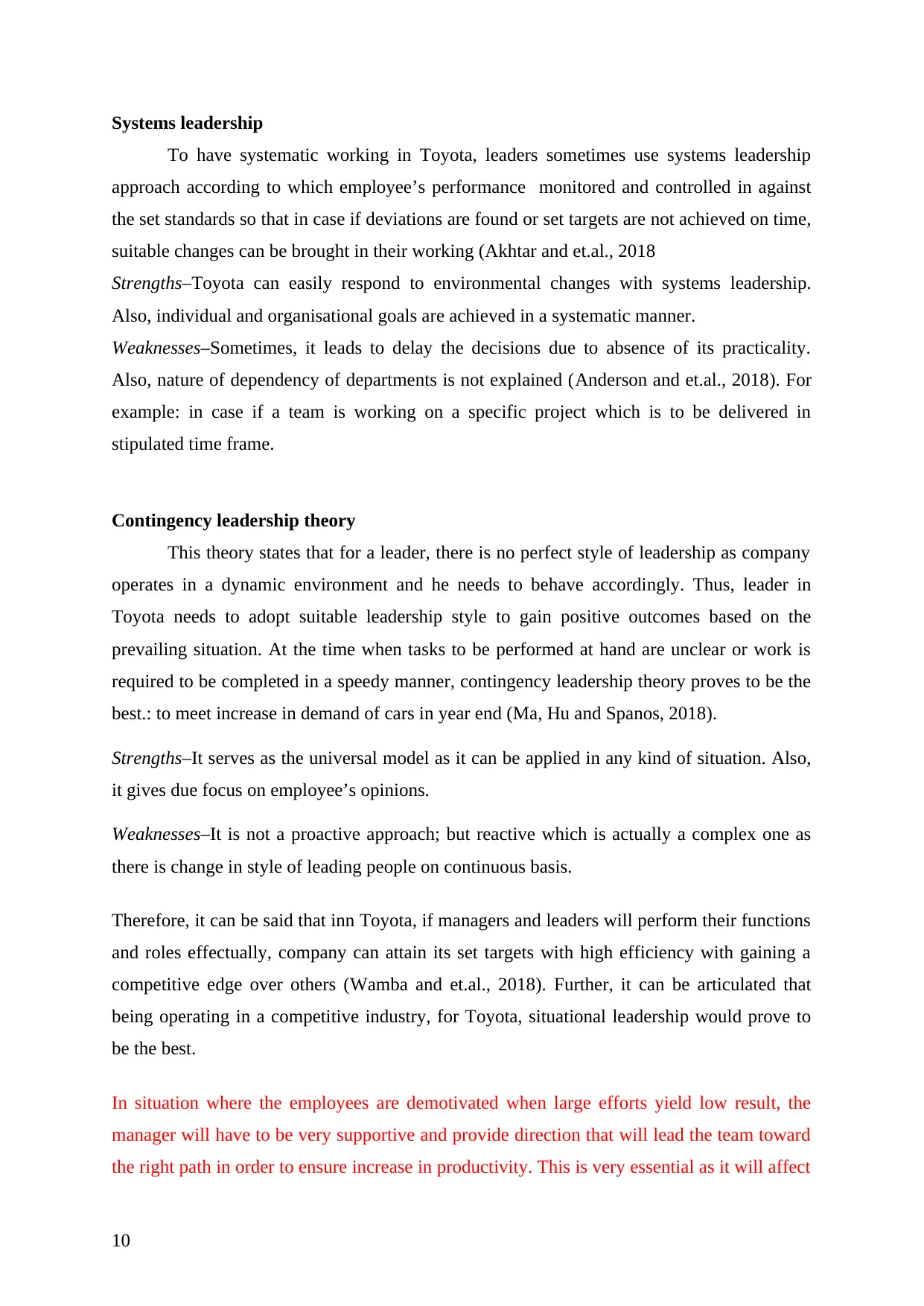
Systems leadership
To have systematic working in Toyota, leaders sometimes use systems leadership
approach according to which employee’s performance monitored and controlled in against
the set standards so that in case if deviations are found or set targets are not achieved on time,
suitable changes can be brought in their working (Akhtar and et.al., 2018
Strengths–Toyota can easily respond to environmental changes with systems leadership.
Also, individual and organisational goals are achieved in a systematic manner.
Weaknesses–Sometimes, it leads to delay the decisions due to absence of its practicality.
Also, nature of dependency of departments is not explained (Anderson and et.al., 2018). For
example: in case if a team is working on a specific project which is to be delivered in
stipulated time frame.
Contingency leadership theory
This theory states that for a leader, there is no perfect style of leadership as company
operates in a dynamic environment and he needs to behave accordingly. Thus, leader in
Toyota needs to adopt suitable leadership style to gain positive outcomes based on the
prevailing situation. At the time when tasks to be performed at hand are unclear or work is
required to be completed in a speedy manner, contingency leadership theory proves to be the
best.: to meet increase in demand of cars in year end (Ma, Hu and Spanos, 2018).
Strengths–It serves as the universal model as it can be applied in any kind of situation. Also,
it gives due focus on employee’s opinions.
Weaknesses–It is not a proactive approach; but reactive which is actually a complex one as
there is change in style of leading people on continuous basis.
Therefore, it can be said that inn Toyota, if managers and leaders will perform their functions
and roles effectually, company can attain its set targets with high efficiency with gaining a
competitive edge over others (Wamba and et.al., 2018). Further, it can be articulated that
being operating in a competitive industry, for Toyota, situational leadership would prove to
be the best.
In situation where the employees are demotivated when large efforts yield low result, the
manager will have to be very supportive and provide direction that will lead the team toward
the right path in order to ensure increase in productivity. This is very essential as it will affect
10
To have systematic working in Toyota, leaders sometimes use systems leadership
approach according to which employee’s performance monitored and controlled in against
the set standards so that in case if deviations are found or set targets are not achieved on time,
suitable changes can be brought in their working (Akhtar and et.al., 2018
Strengths–Toyota can easily respond to environmental changes with systems leadership.
Also, individual and organisational goals are achieved in a systematic manner.
Weaknesses–Sometimes, it leads to delay the decisions due to absence of its practicality.
Also, nature of dependency of departments is not explained (Anderson and et.al., 2018). For
example: in case if a team is working on a specific project which is to be delivered in
stipulated time frame.
Contingency leadership theory
This theory states that for a leader, there is no perfect style of leadership as company
operates in a dynamic environment and he needs to behave accordingly. Thus, leader in
Toyota needs to adopt suitable leadership style to gain positive outcomes based on the
prevailing situation. At the time when tasks to be performed at hand are unclear or work is
required to be completed in a speedy manner, contingency leadership theory proves to be the
best.: to meet increase in demand of cars in year end (Ma, Hu and Spanos, 2018).
Strengths–It serves as the universal model as it can be applied in any kind of situation. Also,
it gives due focus on employee’s opinions.
Weaknesses–It is not a proactive approach; but reactive which is actually a complex one as
there is change in style of leading people on continuous basis.
Therefore, it can be said that inn Toyota, if managers and leaders will perform their functions
and roles effectually, company can attain its set targets with high efficiency with gaining a
competitive edge over others (Wamba and et.al., 2018). Further, it can be articulated that
being operating in a competitive industry, for Toyota, situational leadership would prove to
be the best.
In situation where the employees are demotivated when large efforts yield low result, the
manager will have to be very supportive and provide direction that will lead the team toward
the right path in order to ensure increase in productivity. This is very essential as it will affect
10
Paraphrase This Document
Need a fresh take? Get an instant paraphrase of this document with our AI Paraphraser
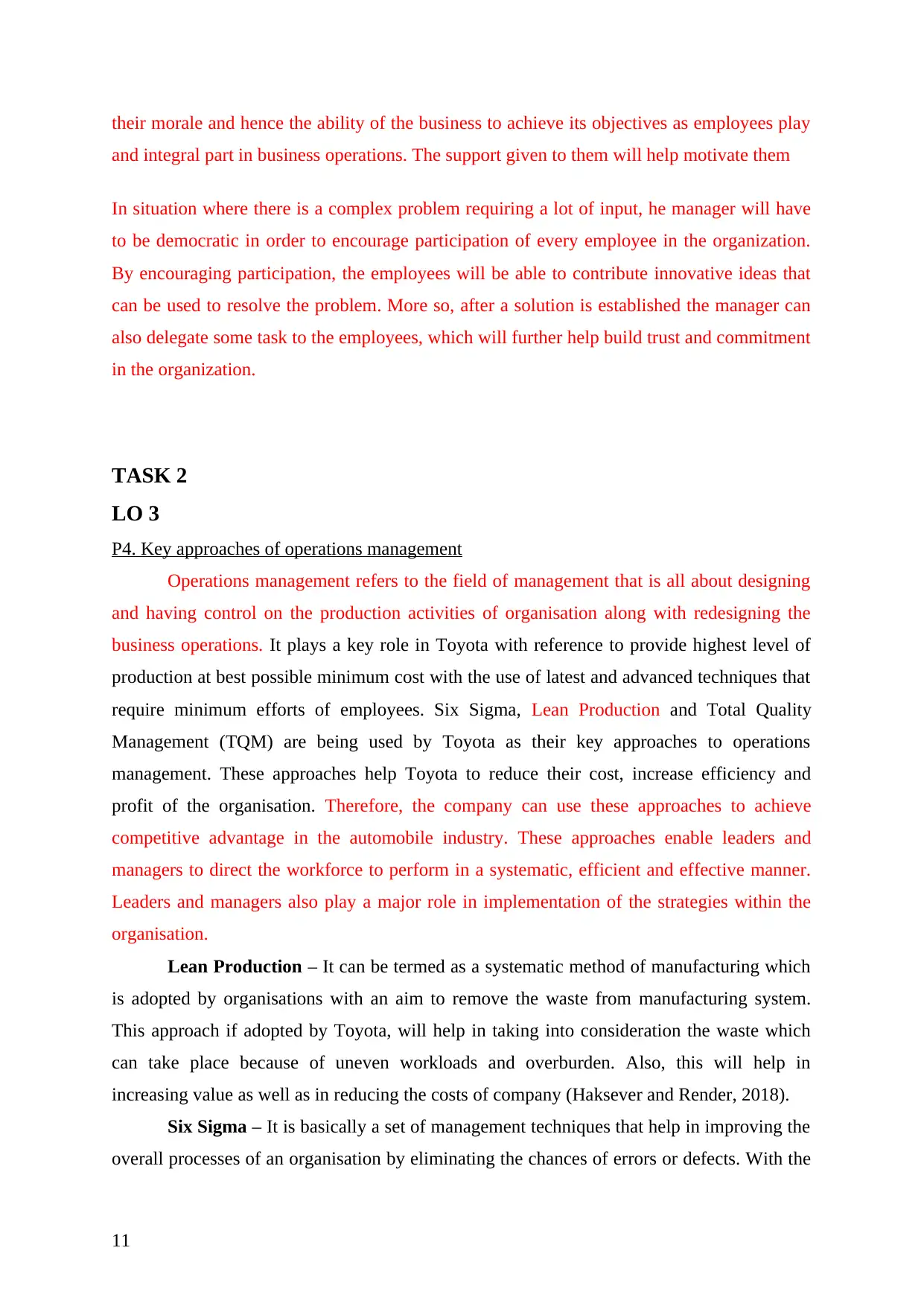
their morale and hence the ability of the business to achieve its objectives as employees play
and integral part in business operations. The support given to them will help motivate them
In situation where there is a complex problem requiring a lot of input, he manager will have
to be democratic in order to encourage participation of every employee in the organization.
By encouraging participation, the employees will be able to contribute innovative ideas that
can be used to resolve the problem. More so, after a solution is established the manager can
also delegate some task to the employees, which will further help build trust and commitment
in the organization.
TASK 2
LO 3
P4. Key approaches of operations management
Operations management refers to the field of management that is all about designing
and having control on the production activities of organisation along with redesigning the
business operations. It plays a key role in Toyota with reference to provide highest level of
production at best possible minimum cost with the use of latest and advanced techniques that
require minimum efforts of employees. Six Sigma, Lean Production and Total Quality
Management (TQM) are being used by Toyota as their key approaches to operations
management. These approaches help Toyota to reduce their cost, increase efficiency and
profit of the organisation. Therefore, the company can use these approaches to achieve
competitive advantage in the automobile industry. These approaches enable leaders and
managers to direct the workforce to perform in a systematic, efficient and effective manner.
Leaders and managers also play a major role in implementation of the strategies within the
organisation.
Lean Production – It can be termed as a systematic method of manufacturing which
is adopted by organisations with an aim to remove the waste from manufacturing system.
This approach if adopted by Toyota, will help in taking into consideration the waste which
can take place because of uneven workloads and overburden. Also, this will help in
increasing value as well as in reducing the costs of company (Haksever and Render, 2018).
Six Sigma – It is basically a set of management techniques that help in improving the
overall processes of an organisation by eliminating the chances of errors or defects. With the
11
and integral part in business operations. The support given to them will help motivate them
In situation where there is a complex problem requiring a lot of input, he manager will have
to be democratic in order to encourage participation of every employee in the organization.
By encouraging participation, the employees will be able to contribute innovative ideas that
can be used to resolve the problem. More so, after a solution is established the manager can
also delegate some task to the employees, which will further help build trust and commitment
in the organization.
TASK 2
LO 3
P4. Key approaches of operations management
Operations management refers to the field of management that is all about designing
and having control on the production activities of organisation along with redesigning the
business operations. It plays a key role in Toyota with reference to provide highest level of
production at best possible minimum cost with the use of latest and advanced techniques that
require minimum efforts of employees. Six Sigma, Lean Production and Total Quality
Management (TQM) are being used by Toyota as their key approaches to operations
management. These approaches help Toyota to reduce their cost, increase efficiency and
profit of the organisation. Therefore, the company can use these approaches to achieve
competitive advantage in the automobile industry. These approaches enable leaders and
managers to direct the workforce to perform in a systematic, efficient and effective manner.
Leaders and managers also play a major role in implementation of the strategies within the
organisation.
Lean Production – It can be termed as a systematic method of manufacturing which
is adopted by organisations with an aim to remove the waste from manufacturing system.
This approach if adopted by Toyota, will help in taking into consideration the waste which
can take place because of uneven workloads and overburden. Also, this will help in
increasing value as well as in reducing the costs of company (Haksever and Render, 2018).
Six Sigma – It is basically a set of management techniques that help in improving the
overall processes of an organisation by eliminating the chances of errors or defects. With the
11
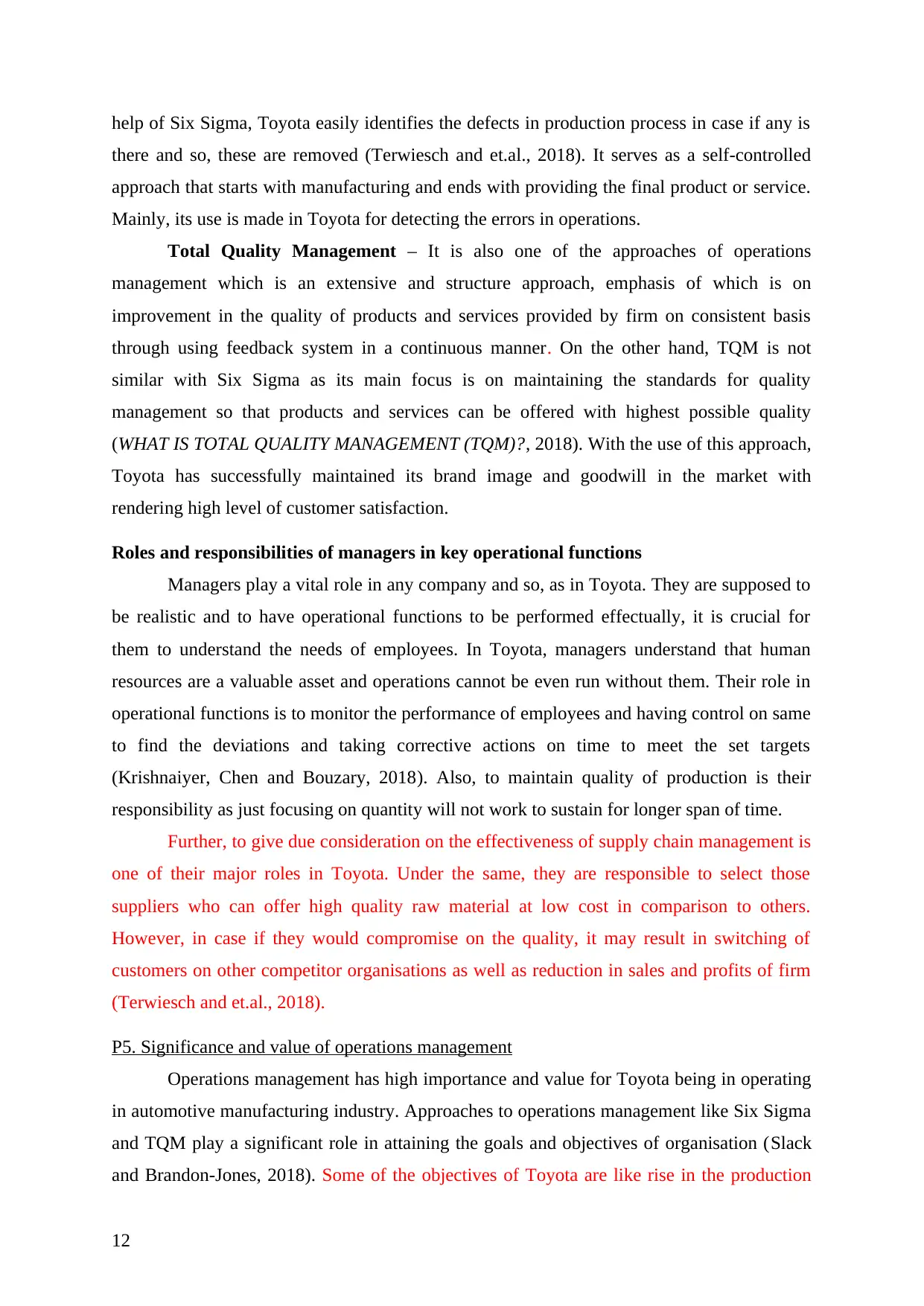
help of Six Sigma, Toyota easily identifies the defects in production process in case if any is
there and so, these are removed (Terwiesch and et.al., 2018). It serves as a self-controlled
approach that starts with manufacturing and ends with providing the final product or service.
Mainly, its use is made in Toyota for detecting the errors in operations.
Total Quality Management – It is also one of the approaches of operations
management which is an extensive and structure approach, emphasis of which is on
improvement in the quality of products and services provided by firm on consistent basis
through using feedback system in a continuous manner. On the other hand, TQM is not
similar with Six Sigma as its main focus is on maintaining the standards for quality
management so that products and services can be offered with highest possible quality
(WHAT IS TOTAL QUALITY MANAGEMENT (TQM)?, 2018). With the use of this approach,
Toyota has successfully maintained its brand image and goodwill in the market with
rendering high level of customer satisfaction.
Roles and responsibilities of managers in key operational functions
Managers play a vital role in any company and so, as in Toyota. They are supposed to
be realistic and to have operational functions to be performed effectually, it is crucial for
them to understand the needs of employees. In Toyota, managers understand that human
resources are a valuable asset and operations cannot be even run without them. Their role in
operational functions is to monitor the performance of employees and having control on same
to find the deviations and taking corrective actions on time to meet the set targets
(Krishnaiyer, Chen and Bouzary, 2018). Also, to maintain quality of production is their
responsibility as just focusing on quantity will not work to sustain for longer span of time.
Further, to give due consideration on the effectiveness of supply chain management is
one of their major roles in Toyota. Under the same, they are responsible to select those
suppliers who can offer high quality raw material at low cost in comparison to others.
However, in case if they would compromise on the quality, it may result in switching of
customers on other competitor organisations as well as reduction in sales and profits of firm
(Terwiesch and et.al., 2018).
P5. Significance and value of operations management
Operations management has high importance and value for Toyota being in operating
in automotive manufacturing industry. Approaches to operations management like Six Sigma
and TQM play a significant role in attaining the goals and objectives of organisation (Slack
and Brandon-Jones, 2018). Some of the objectives of Toyota are like rise in the production
12
there and so, these are removed (Terwiesch and et.al., 2018). It serves as a self-controlled
approach that starts with manufacturing and ends with providing the final product or service.
Mainly, its use is made in Toyota for detecting the errors in operations.
Total Quality Management – It is also one of the approaches of operations
management which is an extensive and structure approach, emphasis of which is on
improvement in the quality of products and services provided by firm on consistent basis
through using feedback system in a continuous manner. On the other hand, TQM is not
similar with Six Sigma as its main focus is on maintaining the standards for quality
management so that products and services can be offered with highest possible quality
(WHAT IS TOTAL QUALITY MANAGEMENT (TQM)?, 2018). With the use of this approach,
Toyota has successfully maintained its brand image and goodwill in the market with
rendering high level of customer satisfaction.
Roles and responsibilities of managers in key operational functions
Managers play a vital role in any company and so, as in Toyota. They are supposed to
be realistic and to have operational functions to be performed effectually, it is crucial for
them to understand the needs of employees. In Toyota, managers understand that human
resources are a valuable asset and operations cannot be even run without them. Their role in
operational functions is to monitor the performance of employees and having control on same
to find the deviations and taking corrective actions on time to meet the set targets
(Krishnaiyer, Chen and Bouzary, 2018). Also, to maintain quality of production is their
responsibility as just focusing on quantity will not work to sustain for longer span of time.
Further, to give due consideration on the effectiveness of supply chain management is
one of their major roles in Toyota. Under the same, they are responsible to select those
suppliers who can offer high quality raw material at low cost in comparison to others.
However, in case if they would compromise on the quality, it may result in switching of
customers on other competitor organisations as well as reduction in sales and profits of firm
(Terwiesch and et.al., 2018).
P5. Significance and value of operations management
Operations management has high importance and value for Toyota being in operating
in automotive manufacturing industry. Approaches to operations management like Six Sigma
and TQM play a significant role in attaining the goals and objectives of organisation (Slack
and Brandon-Jones, 2018). Some of the objectives of Toyota are like rise in the production
12
⊘ This is a preview!⊘
Do you want full access?
Subscribe today to unlock all pages.

Trusted by 1+ million students worldwide
1 out of 19
Related Documents
Your All-in-One AI-Powered Toolkit for Academic Success.
+13062052269
info@desklib.com
Available 24*7 on WhatsApp / Email
![[object Object]](/_next/static/media/star-bottom.7253800d.svg)
Unlock your academic potential
Copyright © 2020–2025 A2Z Services. All Rights Reserved. Developed and managed by ZUCOL.





